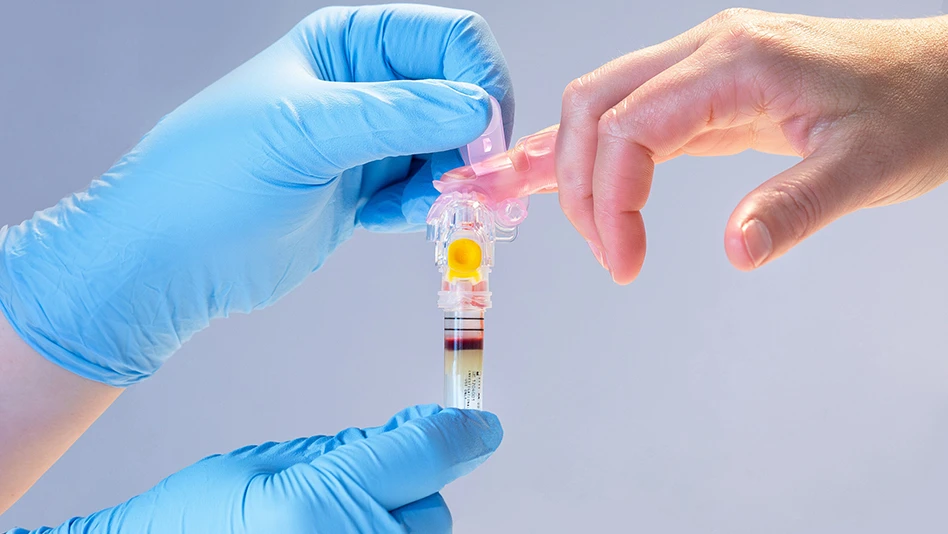
BD
BD (Becton, Dickinson, and Company) has received 510(k) clearances from the U.S. Federal Drug Administration (FDA) for a novel blood collection device that obtains blood samples from a fingerstick that produce lab-quality results for some of the most commonly ordered blood tests.
The BD MiniDraw Capillary Blood Collection System is less invasive than a traditional venous blood draw by using capillary blood collected from a patient's finger by a trained healthcare worker, without the need for a phlebotomist to collect blood from a vein. The innovative design provides a sample that produces lab-quality blood test results from a fraction of the volume of traditional venous collections. It is less invasive than traditional venous blood collection methods and more convenient for the patient by expanding access to blood collection to new locations, including retail pharmacies. The device may provide a better patient experience and has the potential to transform diagnostic testing.
The 510(k) clearances include low-volume blood collection for a lipid panel, selected chemistry tests, and hemoglobin and hematocrit (H&H) testing. These tests are among the most commonly ordered lab tests and can be used to diagnose and monitor a variety of chronic conditions from hypertension to high cholesterol. BD plans to expand blood tests enabled by BD MiniDraw Collection System in the future.
“Because the BD MiniDraw Collection System enables blood collection at non-traditional sites that may be more convenient – like your local pharmacy rather than a standalone lab – we can expand health equity and access, and make it easier for patients to get the blood tests they need both for preventative care and the management of chronic conditions,” says Dave Hickey, executive vice president and president of Life Sciences for BD. “This innovation is our strategy and pipeline coming to life, and proof of our commitment to enabling diagnostics and care in alternate settings.”
Traditionally when a patient requires blood work, a doctor orders the test, and an appointment is made at a laboratory service center where a nurse or phlebotomist draws tubes of blood from the patient's vein. The BD MiniDraw Collection System has the potential to transform this experience by expanding blood testing to new, more convenient settings, which can benefit patients, health care providers and collection sites.
“BD has a 125-year history of transforming health care and expanding access to critical health innovations and technologies,” says Bridget Bagnato, worldwide president of Specimen Management for BD. “Consumers want more convenience, a better experience and to take more control over their health. We believe the BD MiniDraw Collection System is potentially a game-changing innovation that combines convenience and better patient experience with lab-quality results.”
For patients, capillary collection with the BD MiniDraw Collection System provides the convenience of having blood drawn somewhere they already frequent, like a retail pharmacy or grocery store, which may have longer hours of operation and be closer to where they live or work. For these non-traditional collection sites, it enables expansion beyond existing health and wellness programs like administering vaccinations and can generate additional store traffic.
For healthcare providers, capillary blood collection could be offered at a physician's office without the need for a phlebotomist. Making blood collection easier and less invasive may improve patient adherence to blood testing, for example, as part of annual wellness checks, which could lead to earlier diagnosis and better monitoring of chronic conditions.
In May 2022, BD and Babson Diagnostics announced an expansion of their original strategic partnership agreement, announced in 2020, to advance development of the Babson BetterWay blood testing ecosystem, which includes the BD MiniDraw Collection System and Babson's proprietary automated sample-handling and analytical technologies. These were designed to work together to enable blood testing that requires only a fraction of the sample volume of traditional venipuncture methods without sacrificing quality or accuracy.
Latest from Today's Medical Developments
- Walter USA unveils new state-of-the-art campus
- Fixtureworks’ manual-style snap clamps
- Cutting Tool Market Report shows orders up from Sept. 2024
- Mahr’s expanded Precimar SM 60 length measurement family
- Prosthetic material could reduce infections from intravenous catheters
- The Okuma GENOS L3000-e MYW Brings Versatility to the Table
- Replace, Repair, or Retrain? | Okuma
- Master Multitasking with the Okuma MULTUS U3000





